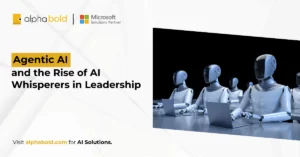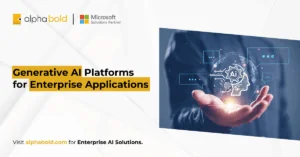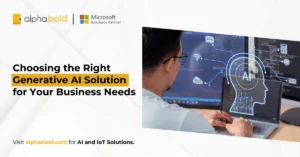AI Buy vs. Build: Which Approach is Right for Your Organization’s Needs?
Table of Contents
Introduction
Artificial Intelligence (AI) has shifted from an experimental technology to a core driver of enterprise strategy. Organizations now apply it to predictive analytics, customer service, fraud detection, and process automation to improve efficiency and maintain competitiveness.
Adoption is accelerating rapidly. McKinsey’s 2025 survey found that 78% of organizations now use AI in at least one business function, up from 72% in early 2024 and just 55% the year before. IT showed the sharpest growth, rising from 27% to 36% in six months, followed closely by marketing, sales, and service operations. This surge shows that AI is no longer optional; it is becoming a baseline capability.
Yet one strategic question shapes every adoption plan: AI Buy vs. Build — should you buy a pre-built AI solution or build one in-house? This blog explores both approaches, their advantages, drawbacks, and use cases, including when a hybrid model may offer the best balance.
What Does It Mean to Buy an AI Solution?
Buying AI means adopting pre-built platforms, APIs, or packaged software vendors have already developed, trained, and tested. These solutions can be integrated into your workflows with relatively minimal setup compared to building custom systems. In the context of AI Buy vs. Build, this approach emphasizes speed, lower upfront investment, and vendor-proven reliability.
Examples include AI-powered chatbots, computer vision APIs, and cloud-based predictive analytics platforms.
Benefits of Buying:
- Speed to Market: Pre-built AI enables rapid deployment. You can roll out solutions in weeks instead of waiting months or years for development cycles. This is especially valuable when time-sensitive use cases exist, such as customer service automation or fraud detection. Early adoption allows organizations to capture ROI quickly and stay ahead of competitors.
- Lower Upfront Investment: Buying AI reduces the need for significant capital outlay. You avoid hiring large data science teams, procuring GPUs, or setting up dedicated R&D infrastructure. Subscription or licensing models spread costs over time, making it easier for organizations with limited budgets to experiment with AI.
- Proven Technology: Vendors typically provide solutions that have been tested across industries, with built-in compliance and regular updates. Instead of managing risks associated with unproven models, organizations benefit from vendor expertise and economies of scale. This is critical in regulated sectors like finance or healthcare, where reliability and compliance are non-negotiable.
- Support and Maintenance: Commercial AI platforms usually come with training, documentation, and technical support. This reduces the dependency on internal IT teams and ensures ongoing optimization. Vendor roadmaps often include feature updates, giving organizations access to the latest innovations without internal development overhead.
Drawbacks of Buying:
- Limited Customization: Pre-built systems offer functionality within a fixed scope. If your business requires unique workflows, proprietary data handling, or niche features, adapting vendor solutions can be difficult or impossible without expensive customization.
- Vendor Lock-in: Over-reliance on a single vendor can limit flexibility. Switching becomes costly and complex if your organization outgrows the platform’s capabilities or the vendor changes pricing/licensing terms.
- Ongoing Costs: While upfront costs are lower, long-term subscription and licensing fees can accumulate. Over time, the total cost of ownership (TCO) may surpass the cost of building, especially if your usage scales significantly.
Best Fit:
Buying AI is most effective for organizations that require standardized capabilities such as chatbots, OCR, or predictive analytics, and need quick wins to demonstrate measurable business value. It is also well-suited for companies that lack in-house AI expertise or the resources to design and maintain custom systems.
In addition, industries where compliance, reliability, and proven vendor support outweigh the need for differentiation, such as finance, healthcare, or government, often find buying AI the more practical and lower-risk option.
Bonus Reading: Generative AI Platforms for Enterprise Applications
What Does It Mean to Build an AI Solution?
Building AI involves developing a custom system: a model, platform, or application designed to meet your organization’s needs. Unlike pre-built tools, which provide standardized capabilities, building AI allows you to design workflows, integrate proprietary data, and align the solution directly with your strategic goals. In the AI Buy vs. Build discussion, this path emphasizes customization, ownership, and long-term competitive advantage.
Examples include custom recommendation engines, predictive maintenance platforms, or domain-specific NLP models.
Benefits of Building:
- Tailored to Your Business: Custom AI solutions are designed around your unique data, workflows, and requirements. This ensures better alignment with business strategy and higher long-term value.
- Competitive Differentiation: Building AI can provide unique features and insights that competitors using off-the-shelf tools cannot replicate, giving you an edge in the market.
- Full Control: You retain ownership of the model, data pipelines, and roadmap. This eliminates dependency on third-party vendors and provides the system with flexibility in evolution.
- Scalability and Flexibility: In-house solutions can be expanded, retrained, or adapted as your business grows, making them more future-proof than vendor-defined platforms.
Drawbacks of Building:
- High Resource Requirements: Building AI demands significant time, budget, and specialized talent, including data scientists, ML engineers, and cloud architects.
- Longer Development Cycles: Results are not immediate. Projects can take months or even years before producing measurable outcomes, delaying ROI.
- Higher Upfront Costs: Infrastructure, R&D, and staffing investments are considerably higher than licensing a vendor solution.
- Ongoing Complexity: Maintenance, retraining, and continuous optimization must be managed internally, adding to operational overhead.
Best Fit:
Custom AI Development for Your Enterprise
Build tailored AI solutions designed to solve your industry-specific challenges and accelerate innovation.
Start Custom AI DevelopmentHow Do You Decide Whether to Buy or Build AI?
The choice between buying and building AI ultimately comes down to your organization’s timeline, resources, and long-term objectives. Executives should carefully assess whether speed, cost efficiency, or strategic differentiation matters most.
While buying offers immediate results with lower risk, building provides control and customization that can pay off over time.
To guide this AI Buy vs. Build decision, consider the following factors:
- Timeline: Do you need AI capabilities deployed immediately, or can your business commit to a longer development cycle?
- Resources: Do you have the in-house budget, infrastructure, and specialized talent to build and sustain AI?
- Business Needs: Are you solving a common challenge like chatbot automation, or do you require proprietary capabilities that off-the-shelf tools cannot deliver?
- Risk Appetite: Can your organization handle the higher risks and uncertainties of building, or is vendor-provided stability a better fit?
- Scalability: Will the chosen solution still serve your business in the next two to five years, or will it limit future growth?
This structured evaluation ensures your AI strategy is not just a technical decision, but a business-aligned investment that drives measurable outcomes.
Can Organizations Take a Hybrid AI Approach?
For many enterprises, the most practical path is not choosing strictly between buying and building, but combining both. A hybrid AI strategy allows organizations to deploy pre-built solutions for speed and reliability while layering custom development where differentiation or deep integration is required. This balance provides vendor tools’ agility with in-house innovation’s flexibility.
Key advantages of a hybrid approach include:
- Faster Deployment: Start with ready-made solutions to immediate needs, while developing custom features over time.
- Controlled Costs: Reduce upfront investments by leveraging vendor infrastructure, then selectively invest in building with higher ROI.
- Flexibility: Adapt vendor solutions with proprietary layers to meet unique industry or regulatory requirements.
- Reduced Risk: Benefit from vendor-proven reliability while minimizing dependency through custom extensions.
A hybrid approach is especially effective in manufacturing, healthcare, and financial services industries, where foundational AI capabilities can be bought off the shelf. Still, compliance, domain-specific needs, or competitive advantage require customization.
Integrate AI into Your Business Systems
Seamlessly connect AI with existing ERP, CRM, and BI platforms to maximize efficiency and ROI.
Integrate AI with My SystemsConclusion
AI’s buy vs. build decision is not about identifying a universally “right” or “wrong” approach but aligning the choice with your business strategy, available resources, and long-term vision.
Buying AI is often the right path for organizations prioritizing speed, simplicity, and predictable costs, while building becomes more valuable when control, differentiation, and scalability are central to competitive advantage.
For many enterprises, however, a hybrid approach offers the best balance, combining the speed and stability of vendor solutions with the flexibility of in-house customization.
Ultimately, the right decision is the one that enables your organization to realize measurable business value from AI investments today while maintaining the flexibility to grow in the future.
FAQs
Yes, upfront costs are lower when buying, but long-term licensing fees may offset savings.
Organizations with proprietary data, skilled teams, and long-term budgets.
Yes, off-the-shelf tools provide fast ROI without heavy technical investment.
Healthcare, manufacturing, and finance often blend pre-built tools with custom layers.
Depending on complexity, projects may take 6–24 months before delivering tangible results.
Explore Recent Blog Posts









